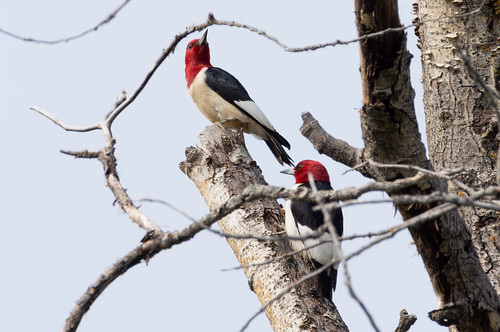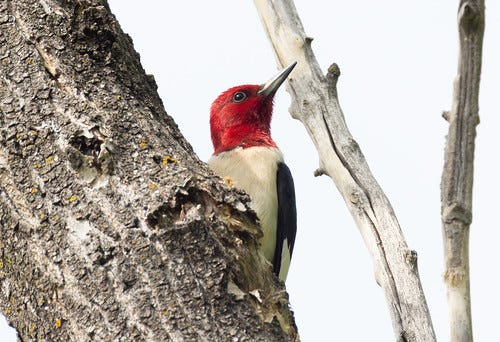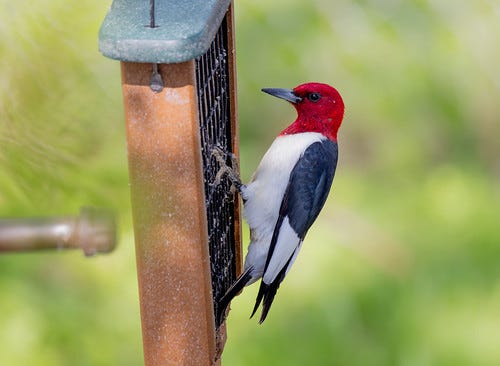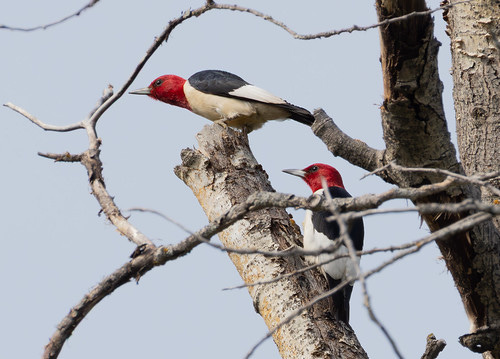Out of the ashes...
Red-headed Woodpecker populations surge during outbreaks of tree diseases.
(Listen to the radio version here.)
In 1904, Japanese chestnut trees imported into the United States from East Asia bore a fungus that Japanese and Asian chestnut trees are resistant to. Tragically, our native chestnuts were not, and by the very next year, the disease had infected trees in the New York Zoological Garden. By 1940, most mature American chestnut trees had been killed, and it’s estimated that by this century, the disease has killed about 4 billion trees. Chestnut blight had all kinds of major ecological impacts, most of them devastating—many species depending on the trees for chestnuts or insects declined, and at least seven native moth species associated with the American chestnut were wiped out completely. Scientists are still working to develop a strain of American chestnuts resistant to the blight, but for those moths, extinction is forever.
Massive trees don’t disappear instantly when they die. Decay from insects and fungus takes a long time to break down the wood, and one bird apparently benefitted from having such a sudden wealth of huge dead trees.
Red-headed Woodpeckers are the most omnivorous of all North American woodpeckers. They eat seeds, nuts, and fruits, adult as well as larval beetles, grasshoppers and cicadas, honeybees, and even bird eggs and baby birds. They often hunt for their insect food from snags, sallying forth to snatch flying insects, dropping to the ground to pick up grasshoppers and such, and in either case, then returning to the snag, often to the exact same perch, in wait for the next opportunity. They also use snags to cache food items in crevices in the wood and to dig roost and nest cavities into the trunk and large limbs. So despite losing an excellent food resource in the form of chestnuts, Red-headed Woodpecker populations benefitted from the sudden abundance of standing dead trees.
Dutch elm disease, another fungal disease imported here on infected lumber and trees, first appeared in the U.S. in the late 1920s, and then a far more virulent form appeared in the 1940s. And again, Red-headed Woodpeckers benefitted from the large number of dead trees providing them with hunting perches, nest and roosting sites, and crevices for caching food.
I didn’t learn about how this beautiful species benefitted from two horrifying tree disease outbreaks until last week when I was researching Red-headed Woodpeckers, inspired by the many birders and non-birders seeing these striking birds all over the Northland, including right here on Peabody Street.
On Saturday, I was watching two of them mating in a big, dead tree behind my yard when it suddenly hit me—that dead tree was an ash, and right now there are a LOT of dead ashes all over up here. The cause of their demise isn’t a fungus—it’s the emerald ash borer, an insect that, in its larval stage, destroys its host tree's vascular system by feeding on the inner bark, preventing the movement of water and nutrients. Unlike chestnut blight and Dutch elm disease, the ashes are dying from insect damage, but once the tree loses its outer bark, fungi get a toehold. When I read that Red-headed Woodpeckers see in the ultraviolet spectrum, and that several tree fungi reflect UV light, I couldn’t help but wonder if this new ash tree disease outbreak might not be the reason for this sudden surge of Red-headed Woodpeckers. These stunning birds belong to one of the few truly migratory species of woodpeckers, and as they fly over the landscape in unfamiliar areas, being able to easily spot decaying trees must be very useful.
Anyway, not all horrible events have a silver lining, and I’m heartbroken that Russ and I lost some of our own ash trees, but the Red-headed Woodpeckers I’m seeing and photographing in my yard and in the big dead ash in the tiny wooded area behind our yard are filling me with joy. They don’t seem to be nesting in that tree, but whatever tree they are nesting in is probably an ash and, whatever species, is almost certainly dead.
Red-headed Woodpeckers are not phoenixes, springing out of the ashes—the trees they need must still be standing. But out of this dead wood is springing new life, and that is cause for celebration.









I may have posted a similar comment on another occasion, but I’ll risk repeating myself.
The very first bird I remember noticing as something special was a Red-headed Woodpecker. It was in a vacant lot across the street from my family’s home in the Woodland neighborhood of Duluth. This piece is a welcome bit of cheer on a gloomy day here at the Head of the Lake!
You have proven once again: we are not too old to learn something new...this time on red-headed Woodpeckers and ash trees!!!!